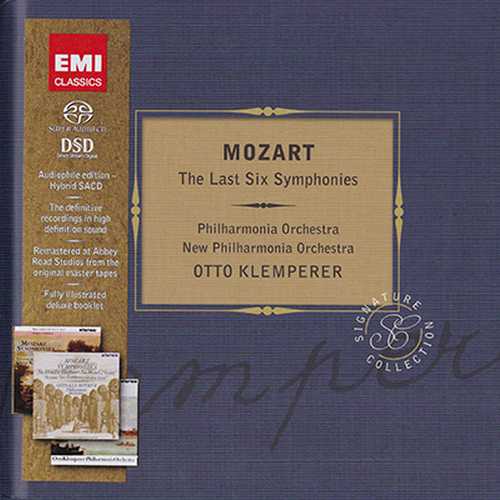
Composer: Wolfgang Amadeus Mozart
Orchestra: Philharmonia Orchestra, New Philharmonia Orchestra
Conductor: Otto Klemperer
Number of Discs: 3
Format: DSD64 (iso)
Label: EMI
Release: 1956-19622012
Size: 6.8 GB
Recovery: +3%
Scan: yes
SACD 01
01. Symphony No. 35 in D, K.385 ‘Haffner’: I. Allegro con spirito
02. Symphony No. 35 in D, K.385 ‘Haffner’: II. Andante
03. Symphony No. 35 in D, K.385 ‘Haffner’: III. Menuetto & Trio
04. Symphony No. 35 in D, K.385 ‘Haffner’: IV. Presto
05. Symphony No. 36 in C, K.425 ‘Linz’: I. Adagio – Allegro spiritoso
06. Symphony No. 36 in C, K.425 ‘Linz’: II. Andante
07. Symphony No. 36 in C, K.425 ‘Linz’: III. Menuetto & Trio
08. Symphony No. 36 in C, K.425 ‘Linz’: IV. Presto
09. Die Entführung aus dem Serail, K.384: Overture
SACD 02
01. Symphony No. 38 in D, K.504 ‘Prague’: I. Adagio – Allegro
02. Symphony No. 38 in D, K.504 ‘Prague’: II. Andante
03. Symphony No. 38 in D, K.504 ‘Prague’: III. Presto
04. Symphony No. 39 in E Flat, K.543: I. Adagio – Allegro
05. Symphony No. 39 in E Flat, K.543: II. Andante con moto
06. Symphony No. 39 in E Flat, K.543: III. Menuetto & Trio
07. Symphony No. 39 in E Flat, K.543: IV. Allegro
SACD 03
01. Symphony No. 40 in G Minor, K.550: I. Molto allegro
02. Symphony No. 40 in G Minor, K.550: II. Andante
03. Symphony No. 40 in G Minor, K.550: III. Menuetto & Trio
04. Symphony No. 40 in G Minor, K.550: IV. Allegro assai
05. Symphony No. 41 in C, K.551 ‘Jupiter’: I. Allegro vivace
06. Symphony No. 41 in C, K.551 ‘Jupiter’: II. Andante cantabile
07. Symphony No. 41 in C, K.551 ‘Jupiter’: III. Menuetto (Allegretto) & Trio
08. Symphony No. 41 in C, K.551 ‘Jupiter’: IV. Molto allegro
klemperer-mozart-the-last-6-symphonies-sacd02.rar – 2.3 GB
klemperer-mozart-the-last-6-symphonies-sacd03.rar – 2.4 GB
In the online discussions about the best recorded versions of the Mozart symphonies there is little reference made to Otto Klemperer, although at one time his EMI recordings of the last several Mozart symphonies were considered the epitome. His various recordings have been available in one form or another ever since his first LPs came out in the late 1950s.
After Klemperer escaped Germany when Hitler came to power, he had a difficult time in the U.S., even getting himself arrested. In 1954 a young agent in NYC arranged for him to conduct a concert in Portland, Oregon. He became famous overnight with his superb performance of Beethoven’s Seventh Symphony, and he ended up in London, where he was asked to conduct EMI’s house band, the Philharmonia. Most British orchestras of the period played well enough to get by but were not first rate. Klemperer fired up the Philharmonia and made London a benchmark for orchestral excellence during the 1960s.
These recordings were originally made in 1956 thru 1962. The first couple of Mozart Symphonies were done in mono in 1956, but then stereophonic recording hit the record business and Klemperer did them over again in stereo for a set of the last six. (No. 37 was discovered in 1907 to have been actually by Michael Haydn, not Mozart.) These are full-bodied performances of great power and knowledge, yet with sensitivity when required. Klemperer may have a reputation for stodgy tempi, but actually the rhythm force of his conducting relieves any of these movements from sounding too slow. The music can still be light and graceful when required – such as in the minuet movements.
Klemper divided up the string sections, making for more interesting spatial effects in stereo, and although the EMI Great Recordings of the Century series did an OK job with reissuing these Mozart performances, they don’t begin to reveal the thrilling and highly detailed sonics heard on this new SACD remastered series. This time EMI’s engineers did it right, playing the original tapes on refurbished Studer open reel decks, using noise reduction judiciously if at all, and converting to 96K/24-bit PCM before mastering to stereo SACD.
This is what might be called big band Mozart, with none of the modern early music refinements coming into play as in the cycles of Pinnock or Hogwood. This is Mozart on modern instruments in a large-sized orchestra – not just 40 musicians like some so-called “authentic” recordings. On the other hand, Klemperer has a different approach to this music that he obviously adored and was fully familiar with. While cycles by Mackerras, Bohm, Karajan, Bruno Walter and others may compete in some ways, Klemperer’s efforts stand up amazingly well now that one can hear details in the recordings which were never exposed before except in the mastering studio.